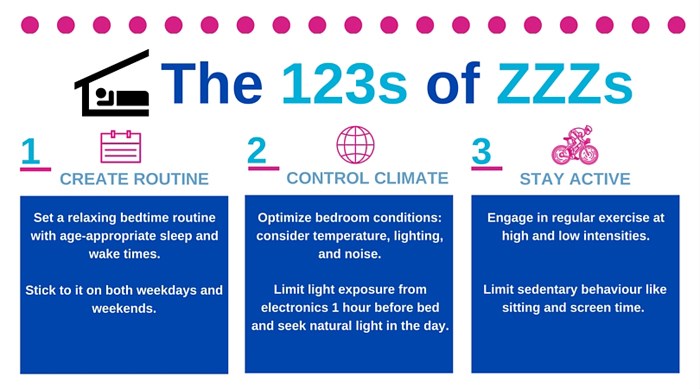Canadian kids face ‘sleepidemic’
Summary:
Dr. Shelly Weiss, neurologist at SickKids, discusses the 'sleepidemic' facing Canadian children.
New 24-hour movement guidelines for kids address sleep for the first time
Dr. Shelly K. Weiss is a neurologist at SickKids who specializes in paediatric sleep disorders. She is also a professor in the Department of Paediatrics at the University of Toronto and was a member of the multidisciplinary team that developed the new 24-Hour Guidelines released in ParticipACTION’s 2016 Report Card.

Almost a third of Canadian school-aged kids and adolescents are sleep-deprived, a problem that ParticipACTION has coined a ‘sleepidemic’. This lack of sleep is associated with more sedentary lifestyles. But it’s a catch-22 because many children are too tired to get enough physical activity during the day and ultimately, are not active enough to be tired at night.
Until now, previous physical activity guidelines for Canadian children addressed physical activity and sedentary behaviour alone. But this year that has changed, and the interrelationship between sleep, physical activity and sedentary behavior is being addressed in ParticipACTION’s 2016 Report Card and new Canadian 24-Hour Movement Guidelines for Children and Youth. A first of their kind in the world, the guidelines outline what a healthy 24-hour period looks like for children and youth.
The guidelines were developed by a group of leading experts, including myself, from across Canada and around the world, with input from over 700 national and international stakeholders in hopes of providing a new way to think about childrens’ health. The infographic is available at the bottom of this page.
The numbers are concerning –only nine per cent of kids get enough physical activity, while 31 per cent of school-aged kids and 26 per cent of adolescents are sleep-deprived. Aside from lower physical activity levels, lack of sufficient sleep is linked to a myriad of negative health implications including hyperactivity, learning and memory problems as well as adverse hormonal changes associated with increased risks of obesity, diabetes and hypertension.
This innovative idea of breaking down children’s health into a 24-hour cycle focuses on optimizing sufficient sleep and expands on physical activity needs to include limiting sedentary behaviour.
These new guidelines include recommendations on the importance of children and youth getting a combination of high levels of physical activity, several hours per day of structured and unstructured light physical activities, no more than two hours of sedentary behavior and sufficient sleep which is nine to 11 hours per night for kids aged five to 13 years, and eight to 10 hours for those aged 14-17 years.
This Report Card offers us a wake-up call. It is essential that we pay attention to the health of Canadian children across the 24 hour cycle, and pay attention to the need for proper sleep at night, as well as ensuring daily high and light levels of physical activity and importantly getting children away from excessive screen time. I encourage everyone to look at the new Canadian 24-Hour Movement Guidelines and share these with your family, friends and colleagues. The potential health impact for Canadian children and youth is enormous.

The 123s of ZZZs
- Create routine. Set a relaxing bedtime routine with age-appropriate sleep and wake times. Stick to it on both weekdays and weekends.
- Control climate. Optimize bedroom conditions: consider temperature, lighting and noise. Limit light exposure from electronis 1 hour before bed and seek natural light in the day.
- Stay active. Engage in regular exercise at high and low intensities. Limit sedentary behaviour like sitting and screen time.

